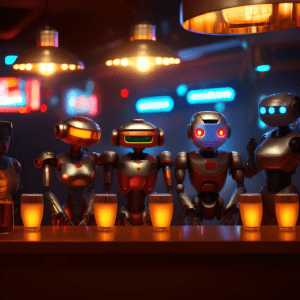It can be easy to think that AI is slowly taking over, and everyone will soon be using robots to create their content.
This fear could have recently been solidified upon learning about the rollout of Google’s Search Generative Experience (SGE).
SGE ultimately has certain SERPs featuring a generative AI answer at the top. In many cases, people will have their queries answered by AI when the SERP loads – then they will move on, taking clicks and traffic away from standard search results.
However, the reality is that if we all relied solely on AI-generated content, we would effectively be living in a 2D world. What’s more, that 2D world would be full of errors – because robots are not perfect, and we shouldn’t treat them as such.
What makes AI-generated content two-dimensional? The fact that it regurgitates information based on what already exists. It bases answers on language models, rather than verified facts.
There is no room for anecdotes, emotion, real-world experience…. all the things that contribute to real life and give it that extra dimension. If we want real, ‘3D’ content, we need humans to be creating it.
With that in mind, here are the 8 AI-proof content tricks we can implement to create quality copy – using the inherent human quirks that robots simply don’t possess.
1. Write personal anecdotes
ChatGPT, Google Bard and Bing Chat walk into a bar.
In reality, they didn’t, because they can’t, and they never will.

Humans can, which means we will all have a wealth of personal experience to draw on when we create content.
Personal anecdotes form a style of content which AI will never be able to replicate. All it will be able to do is draw on existing information and manipulate it according to the prompts you input.
Here’s an example for guide content AI would be capable of producing:
- A factual guide on how to grow tulips based on existing information available online
A gardener would be capable of producing:
- A factual guide on how to grow tulips, drawing on experience they have gained by gardening
- The guide will weave in personal anecdotes, original tips and tricks on how to boost tulip growth in various scenarios
Which one would you rather read?
2. Insert subjective opinion
If you ask ChatGPT for its opinion on a topic, you will typically get a response like this:

Anything written by AI will not contain subjective opinion, as this would require a personal perspective and preference to be provided.
AI will only create content based on observable and verifiable facts.
When it comes to review content, there will be merit to reading about the facts related to a product, which both humans and AI can produce content about.
However, we will be able to drill deeper and develop subjective opinion on these products based on experiencing them and making conclusions based on what we feel.
Ultimately, because your reader can feel, they will be interested in what you feel.
3. Focus on MoFu, BoFu and high-quality ToFu
AI is great at producing ToFu, or top of the funnel, content. This style of content targets informational keywords and provides surface-level answers to questions which require factual details.
If you want a generic, formulaic ToFu blog that won’t meet Google’s EEAT guidelines, then AI is your one-stop shop.
However, you will be able to create in-depth ToFu content that not only provides facts, but is genuinely useful to a reader seeking original insight and perspective they won’t find anywhere else.
AI struggles even more when it comes to creating middle of funnel (MoFu) and bottom of funnel (BoFu) content.
For example, if you were creating a white paper (MoFu), you would need to write in an engaging, authoritative and conversational tone, structure a multi-page document in a user-friendly manner and upsell your solution to the topic being discussed.
These are all things AI won’t be able to replicate like we can.
When it comes to BoFu content, we could try asking AI to create, for example, a tutorial of our product or service. However, it won’t be able to speak from experience of using it – so how can it educate others?
4. Get fact checking
We all remember when Google Bard famously got a fact wrong.
Bard is an experimental conversational AI service, powered by LaMDA. Built using our large language models and drawing on information from the web, it’s a launchpad for curiosity and can help simplify complex topics → https://t.co/fSp531xKy3 pic.twitter.com/JecHXVmt8l
— Google (@Google) February 6, 2023
However, AI does get information wrong sometimes – and it isn’t just Google Bard which is guilty of this.
The reality is that AI should not be used as a replacement for education. It isn’t the new Wikipedia, and you shouldn’t throw your dictionary or encyclopaedia away now that generative AI is widely available.
In fact, AI explicitly tells us that it either cannot fact check, or should not be relied on for accurate or complete results:


Ultimately, the best way to ensure our content is accurate is by fact checking it ourselves.
If we are creating expert content, we should be an expert in it ourselves to align with EEAT. Furthermore, we can consult with other experts to fact check our work.
5. Write with structure and without formula
AI can provide a certain level of structure – particularly if you are asking it to write content with a basic formula, such as a how-to blog on a simple topic.
However, if you are writing a longer-form piece of content, relying on AI to help you structure it would not be wise.
This is because AI is good at formula – not creating a solid outline. You may have noticed that AI copy follows the same formula for each paragraph sometimes – this is its way of sticking to the topic, as it extracts commonalities in structure from its large language model.
However, humans will (hopefully!) recognise that this formulaic layout is repetitive and doesn’t add value. Your best bet is to use your expertise to build out a solid structure for your content yourself – a structure which supports the meaning you’re trying to convey.
6. Compare and contrast with flair
AI can compare and contrast products, services, concepts…any entity you want it to, based on existing information and observable facts.
Its rationale for comparison will often be relatively succinct and concise, based in watertight logic with a one-size-fits-all application.
However, when we want to compare two things, we generally want to dig into the nuances.
For example, we may not want to know what the best smartphone is purely based on its specifications.
We will also want to dig into what makes a particular smartphone the best choice for our individual situation.
Everyone is different – our careers, lifestyles, hobbies, level of technical knowhow, smartphone user habits, financial situation and more will vary from person to person.
Therefore, we will seek comparisons from people who can speak from experience.
Dig into all of the relevant features of a product and examine how they could help – or hinder – various types of people.
7. Demonstrate how to use products and services
As we have mentioned, AI will never be able to do things in the real world and draw on those experiences when it creates content for us.
Therefore, it will never be able to provide demonstrations of how to use products and services.
Sure, it will be able to find facts which already exist about commonly accepted ways to perform certain actions or routines, but there are many concepts it will never be able to effectively demonstrate.
For example, AI will never be able to demonstrate the best way to get through a difficult level on a computer game, or actively troubleshoot a problem you are having with your smartphone.
This is where humans can – and always will – shine. Keep demonstrating how to do things, and your audience will keep coming to you for the answers they need.
8. Reference proof of expertise
In short, a generative AI model will never be a qualified doctor. It will just be able to spit out information that is available online about various medical topics.
Ultimately, we are going to trust information that comes from a qualified expert who has invested time and resources into becoming a master in their field.
To adhere with EEAT, we recommend weaving proof of your expertise into your copy. For example, you may be a professional gardener with 20 years of experience. If you are writing about how to plant and grow tulips to their full potential, you can include snippets such as ‘When I first started growing tulips back in 1982…’.
Furthermore, include an explicit overview of your expertise in your online bios. If you’re a qualified doctor, tell the internet when and where you got your qualification, and how long you’ve been a professional. Your audience will come to you for medical content over information an AI model regurgitates.
Need our help?
When ChatGPT was first released, you may have used it to build out some of your content. However, if you want to add that human dimension it needs to adhere with EEAT guidelines, we’re here to help.
We have a limited number of Free Acquisitions Workshops left this month, so get in touch today and find out what you need to do to take your organic strategy to the next level.












